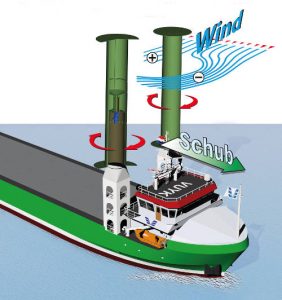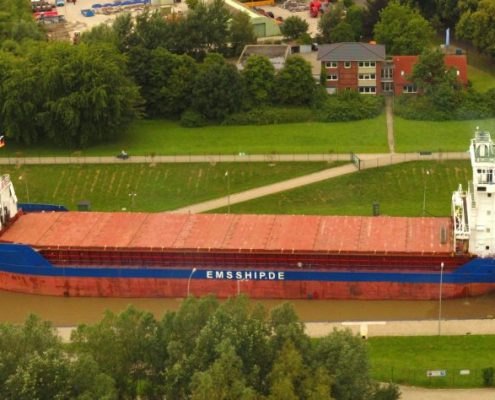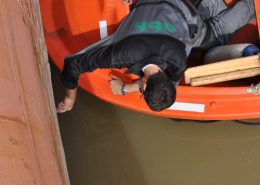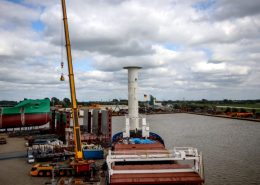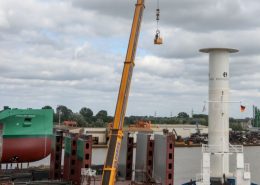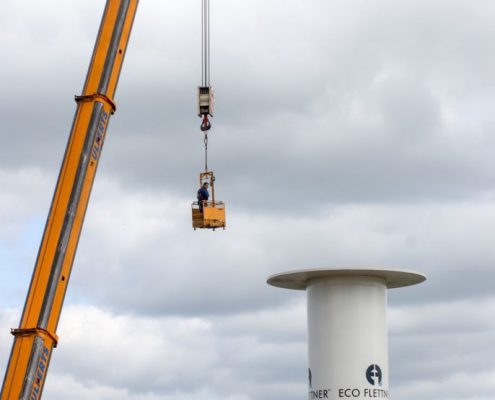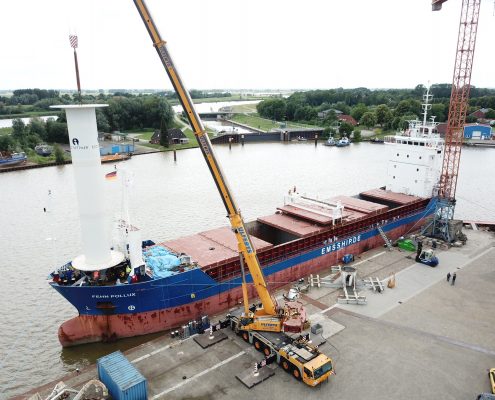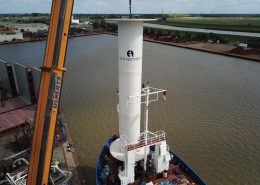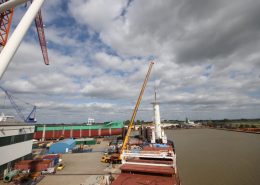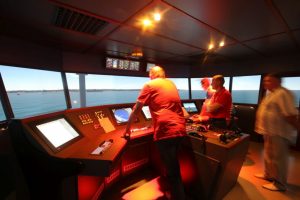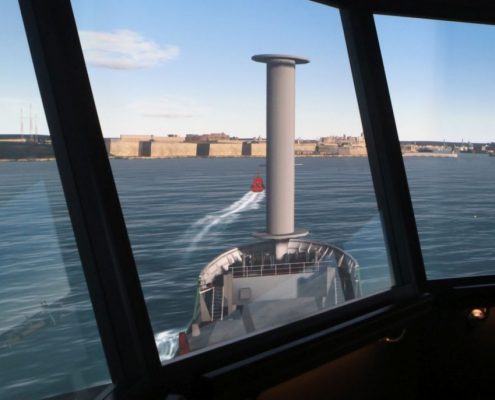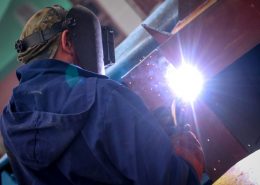Installation of EcoFlettner – Rotor onboard MS „Fehn Pollux“
Background
How can ships be operated in a particularly efficient and environmentally friendly manner? One possibility is to use the power of the wind to reduce power of the main engine – for example with a Flettner rotor.
December 6, 2018
Investment into Flettner-Rotor pays off
December 6, 2018 – The performance of the EcoFlettner, which has been tested on the MV Fehn Pollux since July, clearly exceeds the expectations of the scientists. „The data we have evaluated so far significantly outmatch those of our model calculations,“ says Professor Michael Vahs, who has been researching the topic of wind propulsion for seagoing vessels at the University of Applied Science Emden / Leer for more than 15 years. „In perfect conditions, this prototype will deliver more thrust than the main engine.“
15 companies from around Leer have been involved in the development and construction of the sailing system. The whole project is funded by the EU and coordinated by Mariko in Leer. The rotor is 18 meters high and has a diameter of three meters. After lengthy test runs ashore, the rotor is now being tested under real conditions aboard 90-meter-long multi-purpose freighter MV Fehn Pollux.
The University of Applied Sciences has developed a purpose-made measuring and control system for this project, which enables scientists to gather transparent and reliable performance data. „For the first time we are able to get precise thrust measurements for a Flettner rotor,“ says Professor Vahs.
On board MV Fehn Pollux more than 50 different measurements are continuously collected and computed in real time by the Flettner control system on the bridge. The computer uses the data to calculate the optimum settings for the rotor under the current conditions.
„The longer the trial lasts and the more data we get, the more accurate the results will be,“ says Professor Vahs, who has been with the project from the eginning. „But the data gathered so far allows us to say, that the EcoFlettner saves a noticeable amount of fuel. We are also able to prove, that for ship owners the investment into this sailing system is worth considering, because it pays off in a few years. “
Track the ship’s position live on marinetraffic.com
July 20, 2018
Fehn Pullux in Great Yarmouth, UK
The rotor-vessel FEHN POLLUX is alongside in Great Yarmouth/UK today. She is discharging a cargo of wheat she loaded in La Pallice/France. After three weeks in service the Flettner rotor is doing well and first experiences show, that the sailing device is definitively saving fuel.
DAY 24
She is on her way: On Tuesday, 28 June, „Fehn Pollux“ left Leer with the Eco Flettner onboard for sea trials. The three-week shipyard period, during which the ship was also serviced, was thus completed. The team on board tested all systems and checked the manoeuvrability of the ship during the sea trials.
Professor Michael Vahs from the University of Applied Sciences Emden/Leer said: „The rotor works as planned and the ship behaves as calculated“. A representative of the classification society DNV-GL was also on board during the trials, he was very satisfied with the results and performance.
The rotor finished this first operational test under real conditions on the „Fehn Pollux“ successfully.
The automatic control system works well and sets the optimal speed for the rotor according to the wind conditions. The crew does not need to take any active part in the operation. The on-board computer stores all data, which will be analyzed and evaluated by the project team ashore.
Watch this space for updates and first results!
We wish „Fehn Pollux“ a good trip and fair winds!
DAY 18
The Eco Flettner was successfully tested on board today. All systems are working. After completion of the remaining work, the ship can leave the berth with the new wind-assisted ship propulsion system and return into service.
The Fehn Pollux is expected to depart and complete the sea trials on Friday, 22/June 18.
DAY 17
How did the consortium come to design the Flettner rotor and not choose another alternative drive instead? What are the goals associated with the project and what is the political situation like at the moment? Professor captain Michael Vahs from the University of Emden/Leer, who played a major role in the development, talks about this in this short clip.
DAY 16
Today we conducted the so called yard inclining test to determine the mass of the ship and its centre of gravity. This is required by rules for newbuildings and after major conversions in shipbuilding. At the beginning of the test the displacement which equals the mass is determined by reading off precisely the draft scales of the ship. Then a calibrated weight is shifted on deck from one side to the other, usually by crane. The resulting angle of inclination or heeling angle is measured using a thread pendulum or other precise instrument. Shifting moment and heeling angle yield the vertical height of the centre of gravity by calculation. This value is needed to determine the ship’s stability. A ship needs sufficient stability at any time of operation to safeguard against capsizing.
The test was conducted in the presence of the classification society DNV-GL. They were happy wich the results and gave green light to sail.
DAY 15
Torsten Baarts from MFH did a job at windy heights installing the rotor. His task was to insert the cover of the end plate, which is only possible from above and by hand. A crane lifted him up into the air in a work basket and swung him to the EcoFlettner. There Torsten climbed out of the basket and put in the cover plate. The cover does not have to be removed as long as the rotor remains on board.
(Pictures: Berentzen)
DAY 14
It was a good day yesterday: Would everything work as planned putting the EcoFlettner on board? „Until the end, the welders were still busy strengthening the foundation in the ship,“ says project coordinator Ralf Oltmanns. „We were a little worried about the wind,“ says Oltmanns. The wind blew with Bft. force 3 to 4, in gusts up to force 5.
At about 4.15 pm, the move began: The rotor rose into the air on a crane from Ulferts, floated over the harbour for a moment and then moved safely to the MV „Fehn Pollux“. „We secured it well to the foundation there,“ says Oltmanns. The workers fixed the rotor with 36 hexagonal bolts and applied sealing compound at the seams to protect the electronics inside the EcoFlettner against moisture.
„Everything worked out very well,“ says Oltmanns. Tests are planned for the next few days. This involves the rotor itself, but it is also checked whether the control console functions correctly as soon as it has been connected to the rotor. (Pictures: Berentzen / Ulferts)
DAY 13
It’s done! The EcoFlettner has been successfully placed on the MS „Fehn Pollux“ with a crane and has been secured in place on the forecastle.
It looks really good!
More pictures and information will follow.
DAY 12
The work continues – also for the crew. So that they know how the ship behaves with the EcoFlettner on the forecastle, the crew is being trained by Professor Capt. Michael Vahs from the Faculty of Maritime Sciences at the University of Applied Sciences Emden/Leer. The training is conducted at the ship handling simulator of Nautitec GmbH. „Among other things, it’s about getting used to the changed field of vision,“ says Professor Vahs, “ The rotor can cover small objects – the navigators must be prepared for this. The steering characteristics also change a little,“ explains Vahs.
In cooperation with Nautitec, the rotor was especially programmed for the MV „Fehn Pollux“ so that the crew has the same view as in reality from the bridge. „This is the only simulator in the world that allows you to sail with a Flettner rotor on board,“ says Vahs. „This is something truly unique.“ During the training, the crew can also familiarize themselves with the ship’s behaviour in hybrid operation and reduce the main engine power according to the rotor performance. In this way, fuel is also saved in reality. (Pictures: Berentzen)
DAY 9
Onboard „Fehn Pollux“ there is still a lot to do: The rotor needs a power connection. The control console on the bridge also wants to be connected to the rotor. This requires many meters of cable, some of which are laid along the entire ship. Gerrit Böckmann from Dirks Elektrotechnik GmbH is responsible for this. (Photo: Cordsen)
DAY 8
How does a shipping company come up with the idea of equipping one of its ships with an EcoFlettner? Matthias Hesse, Managing Director of Fehn Ship Management in Leer, will talk about this. He is looking forward to the further course of the project and hopes that the fuel savings calculated in advance will be confirmed by the field test.
DAY 7
The control console for the EcoFlettner is also already on board. But what does it actually do once it is connected? Moritz Götting from the Department of Maritime Sciences at the University of Emden/Leer knows this. He programmed the control system.
The EcoFlettner can be operated manually or automatically with the console. „We wanted to keep the operation of the crew as simple as possible,“ says Götting. The EcoFlettner rotates with a maximum of 280 times per minute. „But that doesn’t always make sense, because the rotor itself uses electrical energy to move around,“ says Götting. Therefore, an algorithm takes over these calculations. In automatic mode, the system adjusts the speed and direction of rotation of the rotor according to windspeed and direction. That will be the normal mode of operation on board.
Manual control will only play a role in special circumstances. „Then, for example, it’s a matter of measuring savings when driving a longer distance at constant speed and at different revolutions,“ Götting explains.
The console also displays relevant data, such as rotor temperature and wind speed. It also stores data on the operation of the EcoFlettner, which the scientists will later evaluate. „We expect a positive result,“ says Götting. „We want to verify the fuel savings that we calculated beforehand.“
DAY 6
The designers Siegfried Lais and Alexander Zimmermann from Lais GmbH were at the shipyard today to take a look at the foundation. „Everything must be securely anchored,“ says Lais. „In addition, the foundation must be well aligned. Of course, the rotor must not be slanted.“ The two inspected the foundation on and below deck and also took a look at the bridge. „The rotor causes a shadow sector in the radar image, so a second radar unit is installed,“ says Lais. This is another reason why the „Fehn Pollux“ has been given an extension for the signal mast.
But what about the foundation? „Of course, the work is not yet complete,“ says Lais. „But everything seems to be in order. There is no need for additional reinforcement.“
Day 5
The work is progressing very well: A crane (Ulferts GmbH) has lifted the prepared foundation onto the ship. There it is anchored, aligned and welded in the deck and underlying structure. The alignment is an important step to ensure smooth and proper operation of the rotor. When everything is straight and welded in place, the EcoFlettner can be secured on the foundation. This is expected to happen on Friday (June 8).
Day 3
The foundation for the EcoFlettner rotor is already produced and ready for installation. It takes several hundred hours of work. It is made of individual sheets and weighs 6.5 tons. A crane is required to lift it onto the MS „Fehn Pollux“. On the ship itself it is anchored in the deck and ship’s structure for maximum stability and resiliance against wind and waves. The work is progressing very quickly: The installation of the foundation is already planned for Friday, June 8. (Pictures: Berentzen)
Day 2
Work on the MV „Fehn Pollux“ is already in full swing. The current task is to prepare the foundation of the rotor. The foundation itself will be put in place in the following days. For this purpose, the workers burn and weld on the multi-purpose freighter. For example, a hole in the deck is required to integrate the foundation in the ships structure. The ship also needs a new signal mast on the foredeck. „The previous mast will be covered by the EcoFlettner rotor“, explains Achim Taute of SEC GmbH & Co Shipservices KG from Leer, who is responsible for the installation of the Eco-Flettner. A new entrance to the CO2 room is also being created. The old companionway has been removed. (Pictures: Berentzen)
Day 1
Now we begin: The MV „Fehn Pollux“ has reached Leer today at about 5 o’clock. The EcoFlettner rotor will be installed on the 90-metre long multi-purpose freighter of Fehn Ship Management shipping company from Leer at the SEC shipyard in the coming days. Extensive work is required for the foundation, including welding work and openings in the deck. We also install a fuel meter that measures fuel consumption. Installation of the EcoFlettner is scheduled for just under three weeks.




